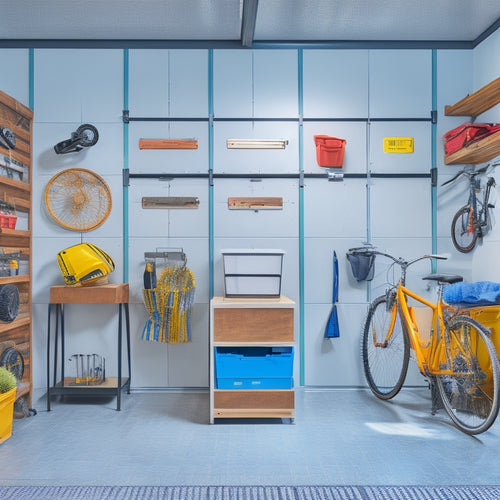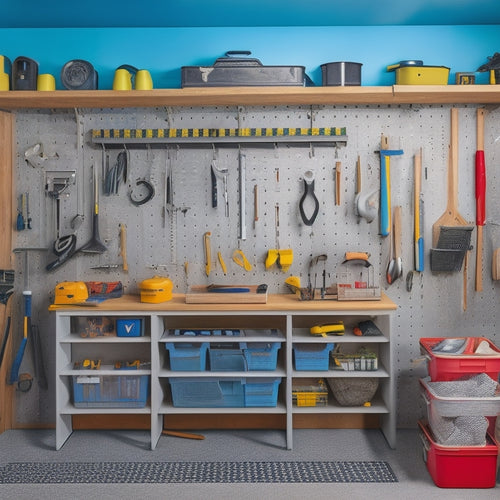
Essential Steps for Garage Storage System Design
Share
You're about to change your cluttered garage into an organized haven by following a structured approach to garage storage system design. Start by evaluating your garage space, analyzing the current layout, measuring dimensions, and identifying areas for optimization. Next, set storage goals and a realistic budget, considering the items you need to store, frequency of use, and desired aesthetic. Then, choose durable materials that balance cost and quality, and design for maximum efficiency, utilizing underutilized areas and implementing vertical storage solutions. From there, incorporate shelving and cabinets, maximize storage space, and organize tools, before adding finishing touches - and with these essential steps, you'll be well on your way to creating a garage that's both functional and beautiful, and you'll soon realize the full potential of your new space.
Key Takeaways
- Assess garage space by evaluating layout, measuring dimensions, and identifying areas for optimization to ensure functionality and traffic flow.
- Set realistic storage goals and budget by defining needs, prioritizing solutions, and allocating contingency funds for unexpected expenses.
- Choose durable and eco-friendly materials that balance cost and quality, and incorporate safety features like slip-resistant flooring and secure shelving.
- Design for maximum efficiency by identifying underutilized areas, implementing vertical storage solutions, and creating designated zones for specific items.
- Incorporate shelving and cabinets that ensure accessibility, verify load capacity, and consider custom features like dividers and bins for optimal organization.
Assessing Your Garage Space
Take stock of your garage's current state by walking into the space and taking a good hard look around. Notice the layout, including the location of windows, doors, and any obstructions like plumbing or electrical fixtures. Measure the dimensions of your garage, including the width, length, and height of the space.
Identify any existing storage systems, such as shelves or cabinets, and take note of what's working and what's not.
As you assess your garage layout, think about space optimization. Consider the flow of traffic in and out of the garage and how you can best employ the space to accommodate your needs.
Think about the items you need to store, such as bikes, tools, or seasonal decorations, and how you can create a functional and efficient storage system.
Take photos and make notes to help you visualize your goals and identify areas for improvement. By taking a thorough inventory of your garage space, you'll be better equipped to design a storage system that meets your needs and enhances your safety.
Setting Storage Goals and Budget
You're now ready to define your storage needs, which involves identifying the items you want to store, how often you'll need to access them, and the types of storage solutions that will work best.
Next, you'll need to set a realistic budget for your garage storage system, considering factors like the cost of materials, labor, and any necessary permits.
Define Storage Needs
Defining your storage needs is an essential first step in designing an effective garage storage system. This involves identifying your priorities and evaluating how you'll use the space.
Start by making a list of the items you want to store in your garage, including seasonal decorations, tools, sports equipment, and vehicles. Reflect on the frequency of use and the size of each item to determine the type of storage solutions you'll need.
Next, think about your daily habits and how you'll access the stored items. Do you need easy access to frequently used items, or can they be stored out of the way? Are there any hazardous materials or heavy objects that require special storage considerations?
You'll also want to reflect on the overall aesthetic you want to achieve in your garage. Do you want a sleek, organized look, or a more functional, utilitarian space?
Set Realistic Budget
Step into the financial planning phase of your garage storage system design by pinpointing a realistic budget that aligns with your storage goals. This vital step guarantees you allocate sufficient funds to achieve your desired storage solutions without breaking the bank.
To set a realistic budget, consider the following factors:
-
Determine the scope of your project: Will you be installing shelves, cabinets, or a slatwall system? This will help you estimate the cost of materials and labor.
-
Research cost-effective solutions: Look for budget-friendly options that meet your storage needs, such as DIY kits or second-hand materials.
-
Prioritize your storage needs: Focus on the most fundamental storage solutions and allocate your budget accordingly.
-
Consider professional installation: If you're not comfortable with DIY projects, factor in the cost of hiring a professional installer.
-
Leave room for contingencies: Unexpected expenses can arise, so it's important to have a buffer in your budget for any unexpected costs.
Assess Available Space
Measure your garage space to determine the maximum storage capacity, identifying areas that can be optimized for storage and those that should remain open for easy movement.
Take precise measurements of the length, width, and height of your garage, including any obstructions like windows, doors, or plumbing fixtures. This will help you visualize your space and identify opportunities for efficient space utilization.
Consider the vertical storage potential in your garage. Think about installing shelves, cabinets, or hooks to maximize storage capacity while keeping the floor clear.
This won't only free up floor space but also reduce clutter and tripping hazards. Make note of any areas that require special attention, such as a workbench or a designated zone for specific activities like bike storage or a potting station.
Choosing the Right Materials
When it comes to your garage storage system, the materials you choose can make all the difference between a functional and stylish space and a cluttered, chaotic one. The right materials can guarantee your system is durable, easy to maintain, and meets your specific needs.
Consider the following factors when selecting materials:
-
Material durability: Choose materials that can withstand the wear and tear of daily use, such as heavy-duty steel or durable plastics.
-
Aesthetic appeal: Select materials that fit your desired style and color scheme, guaranteeing your garage looks organized and visually appealing.
-
Cost effectiveness: Balance the cost of materials with their quality and functionality to guarantee you get the best value for your money.
-
Environmental impact: Opt for eco-friendly materials, such as recycled or sustainable options, to minimize your system's carbon footprint.
-
Safety features: Incorporate materials that promote safety, like slip-resistant flooring and secure shelving, to prevent accidents and injuries.
Designing for Maximum Efficiency
As you plan your garage storage system, you're likely thinking about how to maximize the space you have available. To achieve this, it's essential to focus on designing for maximum efficiency.
Space optimization is key to creating a functional and safe garage. Start by identifying the areas in your garage that are currently underutilized, such as the walls and ceiling.
Consider implementing vertical storage solutions, like hooks, bins, and baskets, to make the most of your garage's vertical space. This will help keep frequently used items within easy reach while keeping the floor clear of clutter.
Additionally, think about the "zones" in your garage, such as a tool zone, sports equipment zone, or seasonal decoration zone. By assigning specific areas for specific items, you'll reduce clutter and make it easier to find what you need when you need it.
Incorporating Shelving and Cabinets
Shelving and cabinets form the backbone of a well-organized garage storage system, providing a solid foundation for storing and protecting your belongings.
When it comes to incorporating shelving and cabinets, you have numerous options to choose from, depending on your specific needs and preferences.
You'll want to take into account the following:
-
Shelving styles: fixed, adjustable, or modular shelving units that can be customized to fit your garage's unique dimensions and storage requirements
-
Cabinet types: base, wall, or overhead cabinets made from durable materials like metal, wood, or composite materials
-
Load capacity: verify your shelving and cabinets can support the weight of your stored items to prevent collapse or damage
-
Accessibility: think about installing shelving and cabinets with easy-to-open doors and drawers to reduce straining and improve accessibility
-
Customization: consider incorporating custom features like dividers, bins, or baskets to maximize storage capacity and organization
Adding Accessories and Finishing Touches
With your shelving and cabinets in place, you're now ready to add the finishing touches to your garage storage system. This is where you can get creative and add functional accessories that enhance the overall organization and functionality of your garage.
Consider installing wall-mounted organizers, such as functional hooks or adjustable shelving, to maximize your storage space.
Add decorative bins and labeled containers to keep small items, like nuts and bolts, organized and easily accessible.
Foldable furniture, like a workbench or table, can provide additional workspace when needed.
Don't forget to incorporate tool storage solutions, like overhead racks or cabinets, to keep your tools organized and out of the way.
Frequently Asked Questions
Can I DIY My Garage Storage System or Do I Need Professional Help?
You can DIY your garage storage system, but consider your skills and time; if you're unsure, professional help guarantees a safe and functional design, incorporating essential DIY tips and design considerations that meet your unique needs and guarantee a secure space.
How Do I Ensure My Storage System Is Earthquake-Resistant?
You'll want to guarantee your garage storage system can withstand earthquakes by anchoring heavy cabinets and shelves to walls, using seismic-rated fasteners, and choosing materials that promote structural stability, prioritizing earthquake safety in your design.
Are There Any Specific Building Codes I Need to Consider?
Coincidentally, you're asking about building codes just as the International Building Code (IBC) celebrates its 25th anniversary! You'll want to check local regulations and adhere to safety standards, ensuring your garage storage system meets seismic and structural requirements, guaranteeing a safe and secure space.
Can I Store Hazardous Materials Like Paint and Chemicals in My Garage?
You shouldn't store hazardous waste like paint and chemicals in your garage, as they can ignite or leak, causing harm; instead, consider separate, well-ventilated storage areas with safety features like spill containment and fire-resistant materials.
How Do I Keep My Garage Storage System Clean and Organized Over Time?
You'll maintain your garage storage system by scheduling regular shelf maintenance, implementing decluttering strategies like categorizing and containing items, and creating a routine to purge expired or unused items, ensuring a safe and organized space.
Conclusion
You've crafted a garage storage system design that's a masterpiece of efficiency, with every component working in harmony to create a space that's both functional and visually appealing. Like a puzzle, each piece fits together seamlessly, maximizing every inch of your garage. By following these essential steps, you've changed your garage from cluttered chaos to a haven of organization, where everything has its place and a purpose. Your garage is now a reflection of your personality - organized, efficient, and ready to tackle any project that comes its way.
Related Posts
-

3 Pro Garage Organization Ideas to Try Now
You can alter your garage from cluttered chaos to organized oasis with three pro garage organization ideas. First, op...
-

Advantages of a Pegboard System in Your Garage
You can instantly alter your garage into a more organized, efficient, and productive space by installing a pegboard s...
-

Top 5 Small Tool Organizers for Your Workshop
You're looking to optimize your workshop's efficiency with high-quality small tool organizers. Compact storage soluti...


